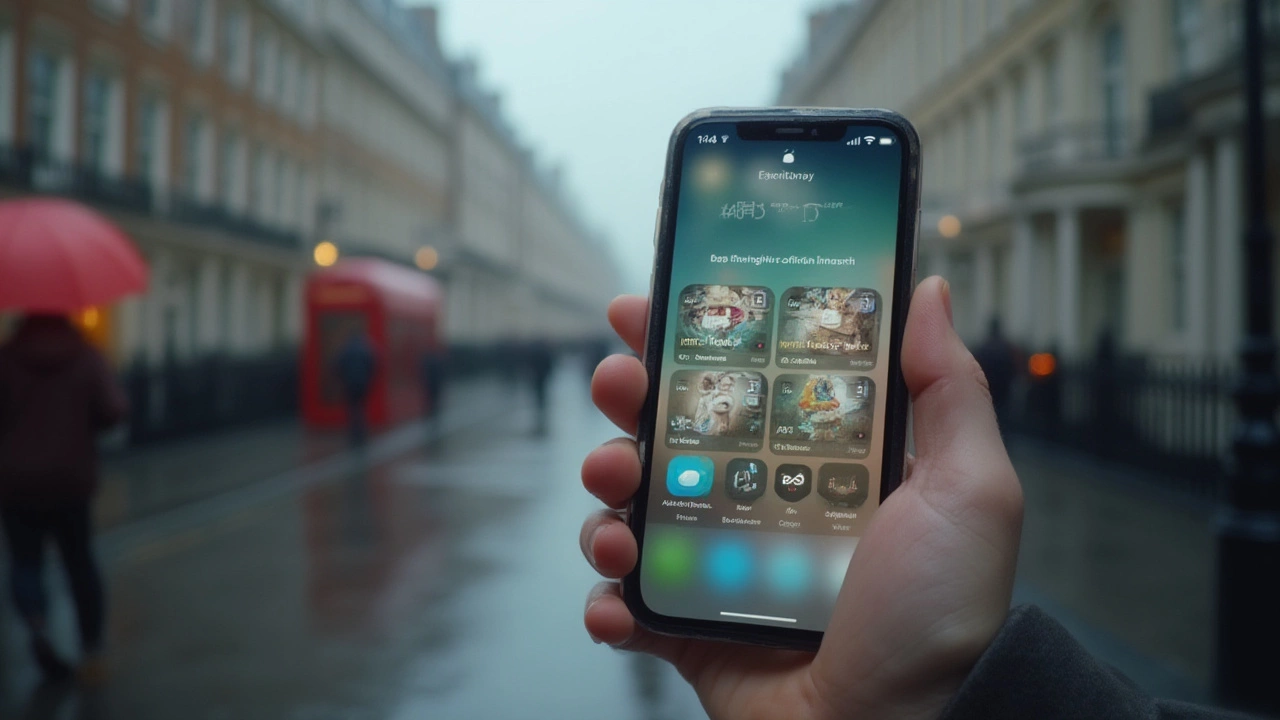Free Up Phone Memory: Practical Ways to Clear Storage Fast
 Jul, 26 2025
Jul, 26 2025
You ever looked at your phone and wondered how on earth it filled up so quickly? One day, you’re snapping photos, grabbing apps, and binging videos on the go—then, out of nowhere, you get the dreaded storage warning. It's a modern problem everyone faces, and it's not because you’re a data hoarder. Phones just fill up with stuff you forget about. The good news? There are more fixes than you might think, many hidden in plain sight.
Understanding Where Your Phone Memory Goes
Let’s get real: Our phones don’t fill up overnight. It’s a sneaky build-up. Photos, videos, app data, memes from friends, podcasts you forget to delete, cached files, and those random downloads all pile up. And let’s not forget those “Other” system files that seem to grow like weeds. According to a Statista survey from early 2025, the average smartphone user downloads 42 new apps a year but only uses about 9 of them regularly. That means most people have bloated app lists taking up storage for nothing.
Photos and videos are the real memory hogs. A single minute of 4K video can chomp through nearly 500MB. Screenshots? They may be small, but most users have hundreds, and they add up. Messaging apps also store every sticker, voice note, and shared image unless you clean them out yourself. Even apps you don't open keep gobbling up background data for updates and cache.
Here’s something most folks miss: system cache and app residue. Android and iOS both keep temporary files to speed things up, but they rarely clean up after themselves automatically. Multiply that by every app on your phone and it’s easy to see how storage disappears. And don’t even get started on duplicate files—those copies of photos in different albums or downloads you’ve forgotten about.
Storage breakdowns look roughly like this (for a typical modern phone with 128GB):
| Category | Average Usage (GB) |
|---|---|
| Photos & Videos | 30 |
| Apps & Games | 25 |
| System Files | 15 |
| Music & Podcasts | 8 |
| Messages/Other | 10 |
| Free Space | 40 |
Every bit counts. Even if you’ve got a hefty phone, clutter can kill performance. "A cluttered phone is a slow phone," warns Wired magazine's digital tech columnist,
“Deleting old files isn’t just about saving space, it’s about making sure your phone keeps running fast and smooth.”
Quick Fixes: What to Delete Right Now
If your phone's throwing out 'Storage Almost Full' warnings, start with the easy stuff you won’t miss. Apps are a big chunk. Scroll through those home screens and app drawers; ditch anything you haven’t touched in months. Games you beat ages ago, restaurants’ loyalty apps you haven’t tapped since last spring, one-time conference apps—say goodbye.
Next, head to your gallery. Most folks can wipe out at least 1-2GB just by deleting blurry photos, accidental screenshots, and all those triple-take selfies. TechCrunch found that the average user can reclaim over 10% of phone space this way, no fancy tools needed. Check for duplicate photos—Google Photos’ ‘Free up space’ feature or Apple’s photo suggestions help spot these instantly.
Don’t forget downloads. Open your ‘Files’ or ‘Downloads’ folder; bet you’ll spot PDFs, memes, or install files from months ago. Delete anything you recognize as junk or can redownload if needed. If you use WhatsApp or Telegram, open storage settings there and clear out old media for specific conversations.
For a deeper cut, clear app caches. On Android, go to Settings > Storage > Cached Data and tap to nuke it. For iPhone, you can offload unused apps through Storage settings—it removes the app but keeps its data, so if you re-download, you pick up right where you left off. Some apps let you clear cache inside their own settings, like Instagram or Twitter. Just beware—clearing all data logs you out in most cases.
Audio files and podcasts can also gum up storage over time. Open your music or podcast app settings and nuke any saved episodes you’ve finished. Look for options to download new episodes only when needed. And if you’re old-school with offline music, back up what you care about and delete the rest to cloud services.

Organizing Files for More Space
It’s not just about deleting; organizing helps you see what’s worth keeping. Start by grouping your photos into albums—family, travel, work, pets. This makes it easier to batch-delete later. Both iOS and Android have built-in search tools to help find specific types of files—just type “videos,” “screenshots,” or “selfies.”
Move files you want long-term onto the cloud. Google Photos, Apple iCloud, and Amazon Photos all offer auto-upload and backup. Google Photos gives free ‘Storage Saver’ quality uploads up to 15GB (shared with Drive and Gmail), and Apple’s iCloud starts you with 5GB free. For more, you might need to pay a bit, but usually, $1-3/month saves a ton of headaches. Dropbox and OneDrive are solid if you need something device-agnostic.
Files like receipts, tickets, or documents can be stored in dedicated cloud folders. Google Drive and Dropbox let you scan and upload paper stuff straight from your camera, so you can clear those, too. To stay on top of downloads and random files, create folders by year or topic, then revisit every couple of months to toss what’s stale.
For music, use streaming more. Spotify, Apple Music, and YouTube Music all let you stream your collection from the cloud. Downloaded albums take up precious space fast. If you’re attached to high-res music files, store a handful on your phone and keep the rest on cloud or an external SD card (if your phone supports it).
Here’s a quick checklist to keep digital clutter in check:
- Schedule monthly ‘digital spring cleaning’ days
- Enable automatic cloud backups for photos and videos
- Sort your downloads by date and clear out the oldest
- Batch delete chat media in WhatsApp/Telegram settings
- Use built-in search to find the largest files in storage
A little structure keeps the mess from piling back up. You’ll find things faster and be less likely to run into full storage—especially when you’re trying to capture important moments or download a new app on a whim.
Cloud Storage, SD Cards, and Alternative Solutions
If you’ve tried everything and still feel the squeeze, it’s time for backup plans. Cloud storage is more reliable (and affordable) in 2025 than it’s ever been. Google, Apple, and Amazon all encrypt your data so you don’t need to stress about privacy. As of April 2025, Google One’s 100GB plan is $1.99/month, and Apple matches that price point for 50GB. That’s more space than most people need for daily photos or crucial documents.
For Android users, SD cards are lifesavers. Not every phone supports them, but if yours does, you can bump up your storage by 128GB or even 256GB with a card that costs less than one pizza night. Just don’t forget to actually move media and downloads onto the card. In your settings, select SD card as the default location for photos and media downloads to avoid filling up internal memory by mistake.
If you don’t want to pay for cloud space, try periodically transferring photos and files to your computer. Both Windows and Mac recognize your phone like an external drive when plugged in via USB. This is perfect for storing high-res pictures and home videos you want to keep safe but don’t need instant access to.
Portable flash drives with phone connectors are another great trick. Brands like SanDisk and Kingston make lightning- or USB-C-equipped sticks that plug right into your phone, letting you back up or transfer files on the go. Just make sure you use a reputable brand—cheap off-brand USB drives can corrupt data.
Sometimes, you’ll find stubborn space-eaters you can’t see in standard file explorers. Third-party apps like Files by Google for Android and Phone Cleaner on iOS are safer and smarter about rooting out hidden caches or duplicate files. Still, stay wary of performance booster apps making wild promises—stick to those well-reviewed by big tech blogs or with lots of real user reviews.
Note that some cloud services let you store full-resolution photos, while others compress them slightly to save space. Decide what's more important—crystal-clear image quality or just having everything backed up and off your phone.

Pro Tips to Keep Your Phone Memory in Check
The best way to avoid ‘Storage Almost Full’ panic is to make smart habits part of your tech routine. First up: turn on automatic backups for photos and videos. On Android, you can do this in Google Photos settings; iOS users can go to Settings > Photos > iCloud Photos. This not only keeps memories safe, but lets you confidently remove local copies from your device.
Next, use your phone’s built-in storage analyzer. On iPhones, Settings > General > [Device] Storage shows your biggest storage hogs. Android offers similar breakdowns in Settings > Storage. These tools often suggest quick wins—archiving old conversations, clearing streaming app caches, or offloading apps you use rarely. Pay special attention to the free up phone memory suggestions, as modern phones use machine learning to spot unused items.
Swipe left or right in your gallery to spot grouped suggestions like ‘Similar Photos’ and ‘Large Attachments.’ Delete anything you won’t miss. Messaging apps like WhatsApp, Signal, or Telegram all have dedicated Storage & Data menus; go there to mass-delete old voice notes, GIFs, and group media with a few taps.
Here’s something most people don’t do: turn off automatic downloads in messaging apps. For example, in WhatsApp (Settings > Chats > Media Visibility), you can stop all media from clogging your gallery. The difference after a few months is huge, especially if you have chatty friends who love memes.
Never ignore system updates. Both iOS and Android periodically improve their storage management and optimize background file handling. Manufacturers also release patches to squash storage bugs or memory leaks you wouldn’t catch yourself. Always install updates to keep your phone running at its best.
Last but not least, set reminders (maybe quarterly) to physically connect your phone to a computer and back it up. Even with cloud services, having a second copy of important stuff is just smart.